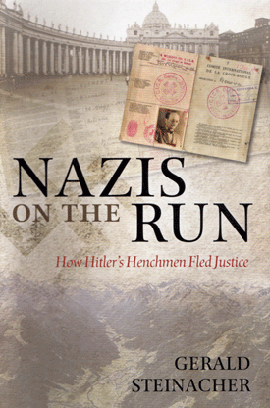Reviewed by NEAL GENDLER
A sad, shameful, too-little discussed fact about the Shoah is that most of the perpetrators got away with it.
Sure, surviving big guys were tried and convicted at Nuremberg, and a number of lesser perps — some guilty of hands-on brutality and killing — also faced justice. Some Twin Cities-area survivors testified against them.
But thanks to entities normally associated with doing good, thousands upon thousands of brutal perpetrators escaped justice, fleeing Europe for sanctuary or even welcome in other regions, especially South America and even more particularly, Argentina.
How they succeeded is made overwhelmingly clear in Nazis on the Run, scholar Gerald Steinacher’s enormously researched account of escape though Italy — enabled not by some alleged ODESSA fugitive underground, but by the International Committee of the Red Cross, Roman Catholic officials and the United States government.
Most Nazis remained in Germany and Austria, Steinacher says, but some of the worst — including Adolf Eichmann, Josef Mengele and Treblinka commander Franz Stangl — fled through Italy, also a popular escape route for collaborators and for legitimate refugees, including Jews seeking to reach Palestine.

Nazis slipped out of lax POW camps in Italy or made their way to southeastern Austria, then into German-speaking South Tyrol, a piece of defeated Austro-Hungary annexed by Italy in 1920.
Thanks to a nationality option granted to South Tyroleans, Nazis could claim to be ethnic Germans from South Tyrol, making them stateless and eligible for ICRC travel documents that worked as passports to leave Italy. Fake IDs were easy to obtain and often vouched for as authentic by church officials to the ICRC.
The ICRC also would issue papers on the word of the refugee and two witnesses. So three Nazis or collaborators could invent false names, claim to be from South Tyrol, or stateless because of Eastern European border changes, vouch for each other and get ICRC documents. Entry visas were obtained easily; Argentina even sent immigration recruiters to Italy.
Steinacher says the ICRC was not a willing partner in escapes, but did little to prevent them, eventually issuing 120,000 travel documents that enabled thousands of Nazis, war criminals and collaborators to escape justice and find refuge in North and South America, Spain and the Near East.
The book’s cover illustration shows Eichmann’s ICRC papers as Ricardo Klement of Belzano, South Tyrol.
South Tyrol offered fleeing Nazis an abundance of comrades, sympathizers and housing for weeks, months and sometimes years. Thousands — in one case, an entire Ukrainian Waffen-SS division of 11,000 — fled Italy with assistance of church officials. In the years after the war, Steinacher writes, “Italian monasteries were swarming with SS men and war criminals from all over Europe who were in hiding.”
Steinacher does not name Pope Pius XII as a co-conspirator, saying the Vatican “was never officially… a giant escape organization.” But he says the pope was proud of his refugee aid commission, which “repeatedly — deliberately or otherwise — helped war criminals to escape.” Many church institutions and dignitaries were motivated to overlook SS histories, seeing Nazis as allies against godless Communism then sweeping Eastern Europe and threatening Italy.
Obsessed with the Cold War, the U.S. quit seeking war criminals for trial in1947, instead using the church-based routes to bring out Nazis and collaborators believed useful for anti-Communist propaganda and intelligence.
Steinacher documents all this in 289 pages of great, even numbing detail: names, aliases, places, dates, document numbers, SS serial numbers and backgrounds of perpetrators and their helpers. One of the worst was Bishop Alois Hudal, an Austrian operating in Rome, “whose picture of the world was defined by German nationalism, anti-Communism and anti-Semitism.” The author quotes Stangl recalling that the bishop “came into the room where I was waiting, held out both his hands, and said, ‘You must be Franz Stangl. I’ve been expecting you.’”
Steinacher does little editorializing. He needn’t; the facts alone are damning.
***
Neal Gendler is a Minneapolis writer and editor.
(American Jewish World, 6.10.11)



















